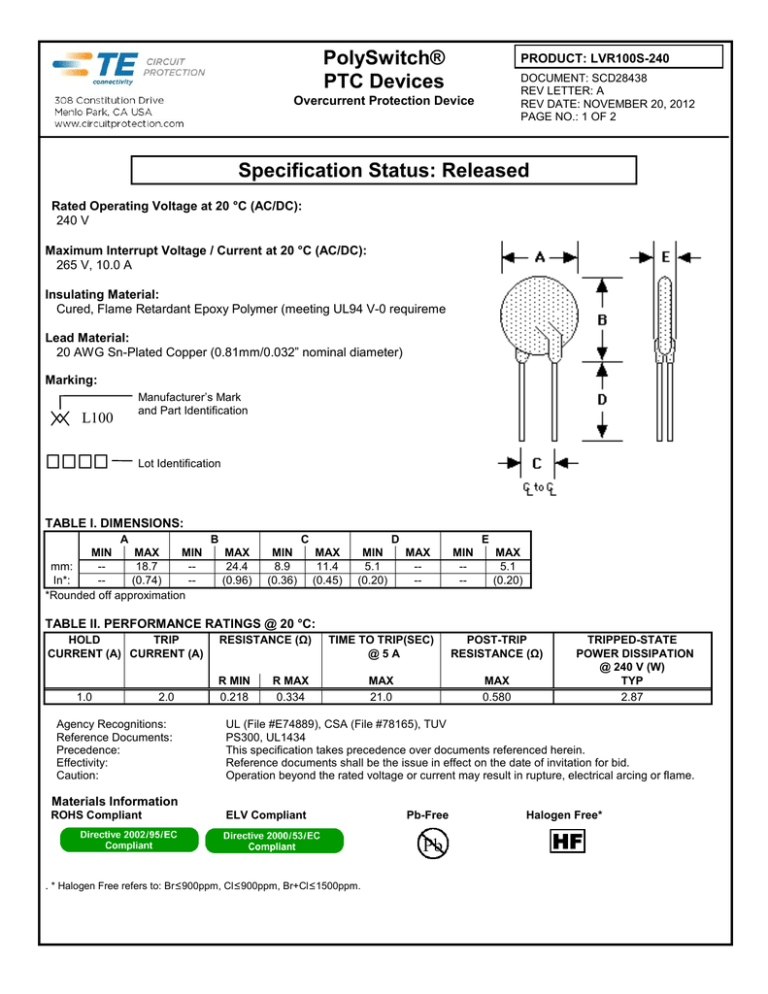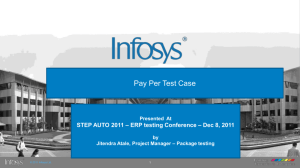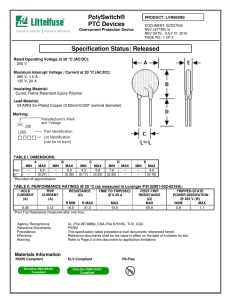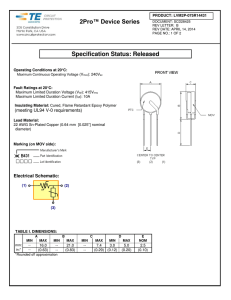
PolySwitch®
PTC Devices
PRODUCT: LVR100S-240
DOCUMENT: SCD28438
REV LETTER: A
REV DATE: NOVEMBER 20, 2012
PAGE NO.: 1 OF 2
Overcurrent Protection Device
Specification Status: Released
Rated Operating Voltage at 20 °C (AC/DC):
240 V
Maximum Interrupt Voltage / Current at 20 °C (AC/DC):
265 V, 10.0 A
Insulating Material:
Cured, Flame Retardant Epoxy Polymer (meeting UL94 V-0 requirements)
Lead Material:
20 AWG Sn-Plated Copper (0.81mm/0.032” nominal diameter)
Marking:
L100
Manufacturer’s Mark
and Part Identification
Lot Identification
TABLE I. DIMENSIONS:
A
B
MIN
MAX
MIN
MAX
mm:
-18.7
-24.4
In*:
-(0.74)
-(0.96)
*Rounded off approximation
C
MIN
8.9
(0.36)
D
MAX
11.4
(0.45)
MIN
5.1
(0.20)
E
MAX
---
MIN
---
MAX
5.1
(0.20)
TABLE II. PERFORMANCE RATINGS @ 20 °C:
HOLD
TRIP
CURRENT (A) CURRENT (A)
1.0
2.0
Agency Recognitions:
Reference Documents:
Precedence:
Effectivity:
Caution:
RESISTANCE (Ω)
R MIN
0.218
TIME TO TRIP(SEC)
@5A
POST-TRIP
RESISTANCE (Ω)
MAX
21.0
MAX
0.580
R MAX
0.334
TRIPPED-STATE
POWER DISSIPATION
@ 240 V (W)
TYP
2.87
UL (File #E74889), CSA (File #78165), TUV
PS300, UL1434
This specification takes precedence over documents referenced herein.
Reference documents shall be the issue in effect on the date of invitation for bid.
Operation beyond the rated voltage or current may result in rupture, electrical arcing or flame.
Materials Information
ROHS Compliant
ELV Compliant
Pb-Free
Halogen Free*
HF
. * Halogen Free refers to: Br≤900ppm, Cl≤900ppm, Br+Cl≤1500ppm.
PolySwitch®
PTC Devices
Overcurrent Protection Device
PRODUCT: LVR100S-240
DOCUMENT: SCD28438
REV LETTER: A
REV DATE: NOVEMBER 20, 2012
PAGE NO.: 2 OF 2
Warning: Application Limitations for the LVR Product Line
1. Users should independently evaluate the suitability of and test each product selected for their
own application.
2. This product should not be used in an application where the maximum interrupt voltage or
maximum interrupt current can be exceeded in a fault condition. Operation beyond the
maximum ratings or improper use may result in device damage and possible electrical arcing
and flame.
3. A PPTC device is not a fuse - it is a nonlinear thermistor that limits current. Under a fault
condition all PPTC devices go into a high resistance state but do not open circuit, so
hazardous voltage may be present at PPTC locations.
4. The devices are intended for protection against occasional overcurrent or overtemperature
fault conditions and should not be used when repeated fault conditions or prolonged trip
events are anticipated.
5. In most applications, power must be removed and the fault condition cleared in order to reset
a PPTC device; however, under certain unusual conditions, a PPTC device may automatically
reset. PPTC devices should not be used in an application where an automatic reset could
create a safety hazard, such as garbage disposals and blenders. Appropriate qualification
testing should be performed.
6. It is the responsibility of the user to determine the need for back up or fail safe protection to
prevent damage that may occur in the event of abnormal function or failure of the PTC device.
7. Operation in circuits with a large inductance can generate a circuit voltage (Ldi/dt) above the
rated voltage of a PPTC device. This product should not be used in an application where the
maximum interrupt voltage or maximum interrupt current can be exceeded by inductive spikes.
8. Devices are not recommended for reflow soldering.
9. Device performance can be impacted negatively if devices are handled in a manner
inconsistent with recommended electronic, thermal, or mechanical procedures for electronic
components.
10. PTC devices are not recommended to be installed in applications where the device is
constrained such that its PTC properties are inhibited, for example in rigid potting materials or
in rigid housings, which lack adequate clearance to accommodate device expansion.
11. Contamination of the PTC material with certain silicone-based oils or some aggressive
solvents can adversely impact the performance of the devices.
© 2012 Tyco Electronics Corporation, a TE Connectivity Ltd. Company.
All rights reserved






